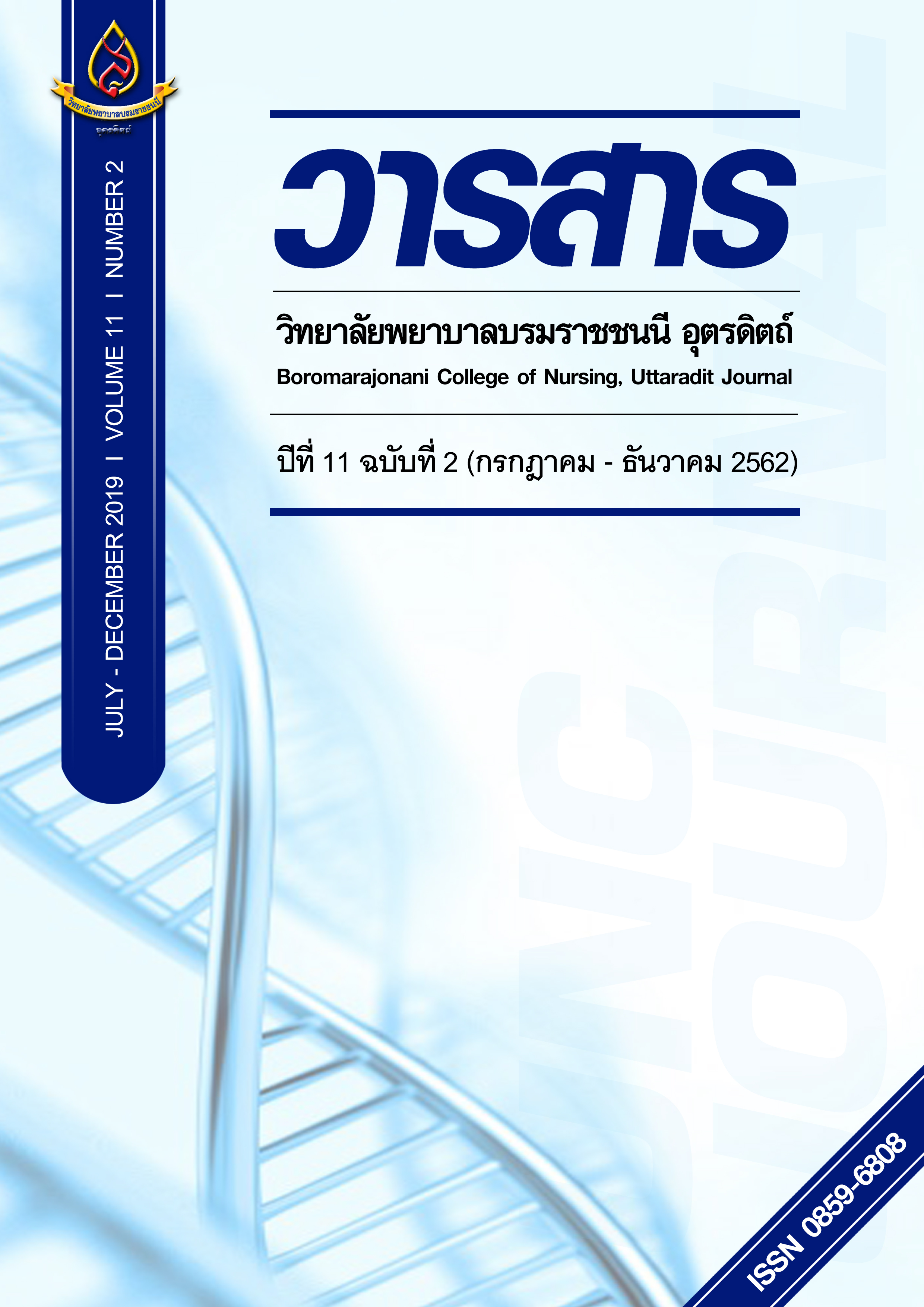การส่งเสริมกิจกรรมทางกายในเด็กโรคหัวใจพิการแต่กำเนิด
Main Article Content
บทคัดย่อ
ธรรมชาติของเด็กทุกคนต้องการเล่น และทำกิจกรรมทางกายต่าง ๆ ตามช่วงวัย เด็กโรคหัวใจพิการแต่กำเนิดก็มีความต้องการเช่นเดียวกัน อย่างไรก็ตามการรับรู้และความเข้าใจของผู้ปกครองเกี่ยวกับกิจกรรมทางกายที่เหมาะสม ยังเต็มไปด้วยข้อสงสัยเกี่ยวกับความปลอดภัยต่อชีวิตของเด็ก ส่งผลให้ผู้ปกครองมีพฤติกรรมการเลี้ยงดูแบบปกป้องมากจนเกินไป รวมไปถึงจำกัดการทำกิจกรรมและการออกกำลังกายของเด็ก พยาบาลเป็นผู้ที่ใกล้ชิดกับเด็กและผู้ปกครองมากที่สุดจึงมีบทบาทสำคัญในการสร้างความเข้าใจและการรับรู้เกี่ยวกับกิจกรรมทางกายที่ปลอดภัย บทความนี้จึงมีวัตถุประสงค์เพื่อเสนอแนวทางและบทบาทของพยาบาลในการส่งเสริมกิจกรรมทางกายในเด็กโรคหัวใจ เพื่อให้ผู้ปกครองมีความมั่นใจ และให้การส่งเสริมกิจกรรมทางกายได้อย่างเหมาะสม เพื่อให้เด็กมีคุณภาพชีวิตที่ดี มีการเจริญเติบโต และพัฒนาการสมวัย
Article Details
บทความหรือข้อคิดเห็นใดใดที่ปรากฏในวารสารวิจัยการพยาบาลและวิทยาศาสตร์สุขภาพ เป็นวรรณกรรมของผู้เขียน ซึ่งบรรณาธิการหรือสมาคมศิษย์เก่า ไม่จำเป็นต้องเห็นด้วย และบทความที่ได้รับการตีพิมพ์เผยแพร่ถือเป็นลิขสิทธิ์ของวารสารวิจัยการพยาบาลและวิทยาศาสตร์สุขภาพ
เอกสารอ้างอิง
2) Babu, A. S., Padmakumar, R., Maiya, A. G., Mohapatra, A. K., & Kamath, R. L. (2016). Effects of exercise training on exercise capacity in pulmonary arterial hypertension: a systematic review of clinical trials. Heart, Lung and Circulation, 25(4), 333-341.
3) Bakheet, M. A., Metwalley, K. A., & Abdel-Raheem, A. S. (2013). Evaluation of persistent pulmonary hypertension of the newborn (PPHN) in Upper Egypt. Egyptian Pediatric Association Gazette, 61(3), 96-99.
4) Centers for Disease Control and Prevention [CDC]. (2015). Congenital heart defects (CHDs), Data & Statistics. Retrieved from https://www.cdc.gov/ncbddd/heartdefects/data.html
5) Colberg, S. R., Sigal, R. J., Yardley, J. E., Riddell, M. C., Dunstan, D. W., Dempsey, P. C., ... & Tate, D. F. (2016). Physical activity/exercise and diabetes: a position statement of the American Diabetes Association. Diabetes care, 39(11), 2065-2079.
6) Diller, G. P., Dimopoulos, K., Okonko, D., Li, W., Babu-Narayan, S. V., Broberg, C. S., ... & Francis, D. P. (2005). Exercise intolerance in adult congenital heart disease: comparative severity, correlates, and prognostic implication. Circulation, 112(6), 828-835.
7) Gielen, S., Laughlin, M. H., O’Conner, C., & Duncker, D. J. (2015). Exercise training in patients with heart disease: review of beneficial effects and clinical recommendations. Progress in cardiovascular diseases, 57(4), 347-355.
8) Haseba, S., Sakakima, H., Nakao, S., Ohira, M., Yanagi, S., Imoto, Y., ... & Shimodozono, M. (2018). Early postoperative physical therapy for improving short-term gross motor outcome in infants with cyanotic and acyanotic congenital heart disease. Disability and rehabilitation, 40(14), 1694-1701.
9) Kao, C. C., Chang, P. C., Chiu, C. W., Wu, L. P., & Tsai, J. C. (2009). Physical activity levels of school-age children with congenital heart disease in Taiwan. Applied Nursing Research, 22(3), 191-197.
10) Laohaprasittiporn, D., Jiarakamolchuen, T., Chanthong, P., Durongpisitkul, K., Soongswang, J., & Nana, A. (2005). Heart murmur in the first week of life: Siriraj Hospital. Journal of the Medical Association of Thailand, 88(8), 163-168.
11) Longmuir, P. E., & McCrindle, B. W. (2009). Physical activity restrictions for children after the Fontan operation: disagreement between parent, cardiologist, and medical record reports. American Heart Journal, 157(5), 853-859. Doi 10.1016/j.ahj.2009.02.014
12) McCrindle, B. W., Williams, R. V., Mital, S., Clark, B. J., Russell, J. L., Klein, G., & Eisenmann, J. C. (2007). Physical activity levels in children and adolescents are reduced after the Fontan procedure, independent of exercise capacity, and are associated with lower perceived general health. Archives of disease in childhood, 92(6), 509-514.
13) Naumoska, L., Dojcinovski, I., Ristovska, F., Saiti, S., T Paunovska, S., & Mitrev, Z. (2012). Qualitative and quantitative Analysis of the Parenting Styles, Coping Strategies and Perceived Stress in Mothers of Children who have undergone Cardiac Interventions. Procedia-Social and Behavioral Sciences, 84, 1809-1814. doi: 10.1016/j.sbspro.2013.07.039
14) Pongpanich B, editor. Problems of Children with Heart Disease in Developing Countries, How Much Can One Do? The First Asia- Pacific Congress of Pediatric Cardiology and Cardiac Surgery; 2006; Bangkok Convention Center (BCC) Sofitel Central Plaza, Bangkok, Thailand.
15) Steeds, R. P., & Oakley, D. (2004). Predicting late sudden death from ventricular arrhythmia in adults following surgical repair of tetralogy of Fallot. Qjm, 97(1), 7-13.
16) Strong, W. B., Malina, R. M., Blimkie, C. J., Daniels, S. R., Dishman, R. K., Gutin, B., ... & Rowland, T. (2005). Evidence based physical activity for school-age youth. The Journal of pediatrics, 146(6), 732-737.
17) Takken, T., Giardini, A., Reybrouck, T., Gewillig, M., Hövels-Gürich, H. H., Longmuir, P. E., ... & Hager, A. (2012). Recommendations for physical activity, recreation sport, and exercise training in paediatric patients with congenital heart disease: a report from the Exercise, Basic & Translational Research Section of the European Association of Cardiovascular Prevention and Rehabilitation, the European Congenital Heart and Lung Exercise Group, and the Association for European Padiatric Cardiology. European journal of preventive cardiology, 19(5), 1034-1065.
18) Trojnarska, O., Gwizdała, A., Katarzynski, S., Katarzynska, A., Szyszka, A., Lanocha, M., ... & Kramer, L. (2009). Evaluation of exercise capacity with cardiopulmonary exercise test and B-type natriuretic peptide in adults with congenital heart disease. Cardiology journal, 16(2), 133-141.
19) World Health Organization. (2009). Interventions on diet and physical activity: what works: summary report.


